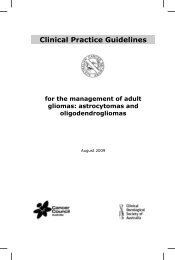Clinical Practice Guidelines for the management of locally advanced ...
Clinical Practice Guidelines for the management of locally advanced ...
Clinical Practice Guidelines for the management of locally advanced ...
Create successful ePaper yourself
Turn your PDF publications into a flip-book with our unique Google optimized e-Paper software.
mono<strong>the</strong>rapy <strong>for</strong> low-to-intermediate risk prostate cancer. There are some institutional series using<br />
low-dose brachy<strong>the</strong>rapy as a boost following external beam radio<strong>the</strong>rapy (EBRT) <strong>for</strong> <strong>locally</strong><br />
<strong>advanced</strong> prostate cancer, but <strong>the</strong>re are no randomised trials evaluating this approach and it is largely<br />
viewed as an experimental approach.<br />
Temporary implant brachy<strong>the</strong>rapy. This involves <strong>the</strong> temporary insertion <strong>of</strong> a radioactive compound<br />
(usually Iridium-192) guided into various positions in <strong>the</strong> prostate via <strong>the</strong> placement <strong>of</strong> multiple<br />
ca<strong>the</strong>ters that have been placed under ultrasound guidance. It is usually per<strong>for</strong>med in combination<br />
with external beam radio<strong>the</strong>rapy <strong>for</strong> patients with intermediate- and high-risk cancers. Occasionally<br />
lower activity compounds can be used in this way administering radio<strong>the</strong>rapy over longer time<br />
periods (e.g. 24-48 hours)<br />
There is a dearth <strong>of</strong> good randomised comparative trials to assist in assessing <strong>the</strong> place <strong>of</strong><br />
brachy<strong>the</strong>rapy in <strong>the</strong> treatment <strong>of</strong> <strong>locally</strong> <strong>advanced</strong> disease. There was only one randomised<br />
controlled trial that assessed <strong>the</strong> efficacy <strong>of</strong> temporary brachy<strong>the</strong>rapy in addition to external beam<br />
radio<strong>the</strong>rapy <strong>for</strong> <strong>locally</strong> <strong>advanced</strong> disease. 88 It was a study <strong>of</strong> 104 T2-3 patients comparing <strong>the</strong> use <strong>of</strong> a<br />
temporary brachy<strong>the</strong>rapy ‘boost’ with an iridium implant (35Gy given in 48 hours) in addition to a<br />
course <strong>of</strong> external beam treatment (40Gy) with external beam treatment alone (66Gy). In <strong>the</strong><br />
brachy<strong>the</strong>rapy plus EBRT arm, 17 patients (29%) experienced biochemical or clinical failure<br />
compared with 33 patients (61%) in <strong>the</strong> EBRT arm (hazard ratio=0.42; P=0.0024). While this study<br />
supported <strong>the</strong> concept that <strong>the</strong> addition <strong>of</strong> HDR like brachy<strong>the</strong>rapy showed ‘efficacy’, <strong>the</strong> comparison<br />
was not useful to guide contemporary practice as <strong>the</strong> external beam radiation dose was 66Gy, which<br />
has been shown to be inferior to higher doses such as 74Gy.<br />
The results <strong>of</strong> this and o<strong>the</strong>r studies comparing brachy<strong>the</strong>rapy with external radiation are difficult to<br />
generalise, since <strong>the</strong>y are essentially comparing <strong>the</strong> same modality packaged in different ways. There<br />
are many o<strong>the</strong>r parameters in radiation treatment that affect <strong>the</strong> disease control probabilities, such as<br />
total dose, radiation technique and total treatment time, in addition to <strong>the</strong> modality <strong>of</strong> radiation, that is,<br />
brachy<strong>the</strong>rapy versus external beam. There are no controls <strong>for</strong> <strong>the</strong>se in many studies, including <strong>the</strong><br />
randomised controlled trial, raising <strong>the</strong> question as to whe<strong>the</strong>r one <strong>of</strong> <strong>the</strong>se o<strong>the</strong>r factors might<br />
account <strong>for</strong> any difference seen between <strong>the</strong> two arms.<br />
In addition, men with <strong>locally</strong> <strong>advanced</strong> disease in Australia are generally treated with <strong>the</strong> combination<br />
<strong>of</strong> androgen deprivation and radiation <strong>the</strong>rapy. There may be interactions with this combination that<br />
fur<strong>the</strong>r confound comparisons.<br />
Evidence summary Level References<br />
There is a paucity <strong>of</strong> high-quality randomised trial data comparing<br />
<strong>the</strong> use <strong>of</strong> brachy<strong>the</strong>rapy to surgery <strong>for</strong> <strong>the</strong> treatment <strong>of</strong> <strong>locally</strong><br />
<strong>advanced</strong> disease, or indeed comparing <strong>the</strong> use <strong>of</strong> brachy<strong>the</strong>rapy<br />
radiation to external radiation. There is one medium-quality<br />
randomised trial. It provides little evidence to guide contemporary<br />
Australian practice, except to <strong>the</strong> extent it demonstrated evidence<br />
<strong>of</strong> effect <strong>of</strong> <strong>the</strong> high dose rate boost. As a result <strong>of</strong> <strong>the</strong> study’s design<br />
it is difficult to draw comparative conclusions from this study.<br />
29<br />
Locally <strong>advanced</strong> disease<br />
II 88



